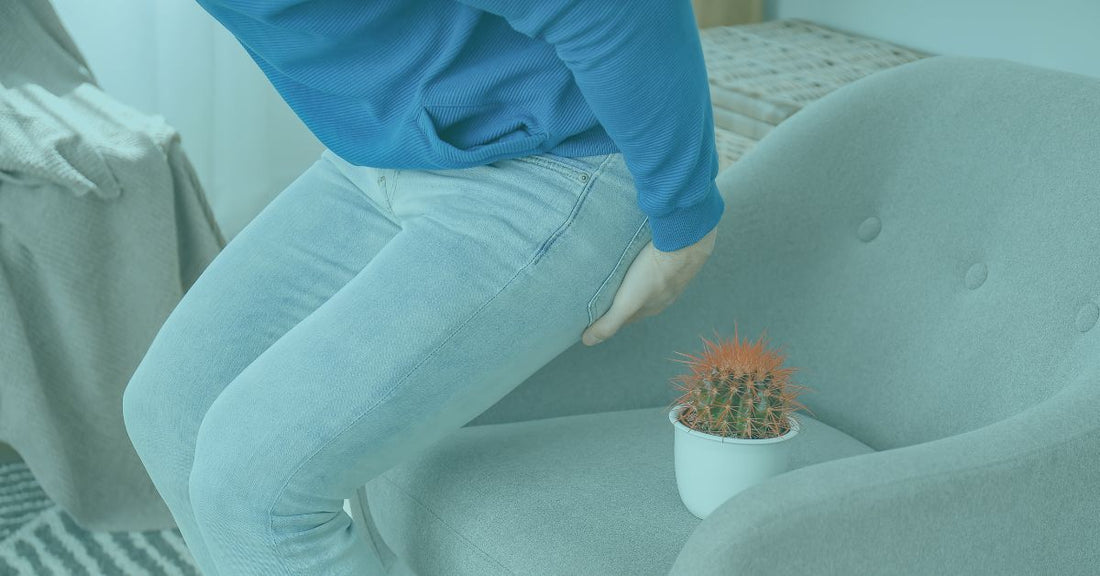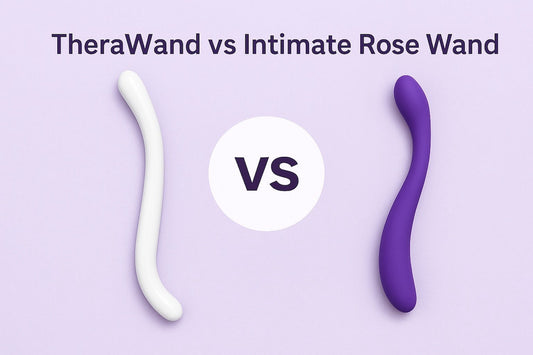Pudendal neuralgia, a painful disorder affecting the pudendal nerve, is often treated with nerve block medication or surgery. Recent research, however, shows that relaxing the pelvic floor through pelvic floor physical therapy is also an effective treatment option.
Read on to learn the best exercises to relieve pudendal neuralgia as per a doctor of physical therapy (DPT) and which pelvic tool is recommended to massage and relax the muscle tissue around the pudendal nerve.
What is Pudendal Neuralgia?
Considered a chronic pelvic pain disorder, pudendal neuralgia is caused by a damaged, irritated, or inflamed pudendal nerve, which runs through the pelvic area and ends in the external genitals.
The pudendal nerve emerges from the sacral plexus at the end of the spine and down the back of the pelvis into the muscles and skin from the anus to the external genitals. There are three branches of the pudendal nerve; a rectal branch, perineal branch, and clitoral/penile branch.
Each branch stimulates muscle movement and sensory data regarding pleasure, pain, temperature and touch in the anus, perineum, and vagina (or penis in men). With pudendal neuralgia, one, two, or three pudendal nerve branches may be affected.
Symptoms of Pudendal Neuralgia
Given the three branches of the pudendal nerve, the symptoms of pudendal neuralgia can vary depending on which branches are damaged.
Pelvic pain is the primary symptom of pudendal neuralgia, often encompassing the anus, rectum, clitoris, labia, and vulva. Described as aching, burning, numbing, prickling, tingling, shooting, or stabbing, pudendal nerve pain can manifest differently for everyone.
Pudendal neuralgia pain is also known to worsen when sitting, alleviate when standing, and intensifies in the evening. In addition to pain, the muscles or organs controlled by the pudendal nerve may also be affected.
For example, if the rectal branch of the pudendal nerve is damaged or irritated, it can cause painful bowel movements. Damage to the other pudendal nerve branches can cause a frequent need to urinate and pain during penetration or sex.
Perineal swelling, or the sensation of something sitting in the anus, is common. As is anxiety, perspiration, and an increased heart rate. Some patients also report a feeling of numbness and chills in the buttocks, legs, and feet.
What Causes Pudendal Neuralgia?
Pudendal neuralgia happens when the pudendal nerve is injured, damaged, irritated, inflamed, or compressed. The most common causes are:
- Traumatic childbirth
- Regular cycling or horseback riding
- Too much squatting
- Chronic constipation
- Sitting for prolonged periods
- Non-cancerous pelvic growths
- Diabetic neuropathy
- Compression from surrounding muscles and ligaments
- Surgical complications
- Broken pelvic bone
Certain infections and pelvic conditions may also contribute to pudendal neuralgia due to the irritation they cause the pudendal nerve. These include genital herpes, recurring urinary tract infections, HIV, and endometriosis.
The Best Pudendal Neuralgia Exercises According to Physical Therapists
Performing the right exercises for pudendal neuralgia can help ease the pain, alleviate irritation, inflammation & tension, and improve muscle tone & flexibility. To achieve this, pelvic floor physical therapists would typically examine each patient to gauge nerve function around the anus, genitals and perineum.
In their clinic, physical therapists use various manual therapy techniques to relieve tension and tightness around the pudendal nerve. At home, patients are encouraged to exercise the pelvic floor and core muscles, stretch the hip and thigh muscles, and perform regular aerobic exercise to enhance blood flow to the pelvic area.
This can be achieved with the following exercises:
Stretching
Due to their anatomical connection to the pelvis, the hip and thigh muscles can tense when pudendal neuralgia occurs. Stretching them reduces tightness and encourages more flexibility in the pudendal nerve to relieve the symptoms of pudendal neuralgia.
To ease tightness in the hip and thigh muscles, physical therapists recommend performing the Shin Box Stretch (on the floor or a chair). Hold the stretch on one side for 15-20 seconds before repeating on the opposite side 2-3 times per day. Side-lying hip abduction & extension and hip extensions in the quadruped position are also recommended.
Core Exercises
Holding a plank, or performing core strengthening wide leg bridges or bird dogs, can help alleviate pressure on the pudendal nerve and improve posture.
Aerobic Exercise
Regular and low impact aerobic exercise such as walking or swimming is also recommended for easing pudendal neuralgia. In addition to increasing blood supply to the pelvic area, aerobic exercise reduces muscle tension, eases pain by releasing endorphins, and improves overall health. Physical therapists recommend 30 minutes of aerobic exercise 3-5 times weekly.
Yoga Poses
The conscious breathing, stretching, and mindfulness of yoga can also help relieve the symptoms of pudendal neuralgia. Yoga asanas such as Baby pose, Cobra pose, and properly executed low squats can help relax the pelvic floor muscles, stretch the hamstrings and hips, while relaxing yoga poses can help ease mental and physical tension.
The symptoms of pudendal neuralgia can manifest uniquely for everyone. So if your pain or discomfort worsens while performing any of the above exercises or stretches, stop doing them and consult with your physical therapist.
Is it Possible to Massage the Pudendal Nerve?
In the clinic, pelvic physical therapists perform tender point release, and gentle mobilization of the muscles and tissues around the pudendal nerve to relieve tension or compression of the nerve.
To replicate this type of massage in the comfort of your home, pelvic physical therapist Dr. Amanda Olson DPT, PRPC developed the Pelvic Wand. Designed as a curved wand as wide as the index finger, the Pelvic Wand can reach deep pelvic trigger points to ease the pain of pudendal neuralgia and other pelvic conditions.
Coated in safe, medical-grade silicone, the wand can be heated or cooled for extra comfort.
Once inserted with the help of lubrication, the tip of the Pelvic Wand is pressed gently against the pelvic floor muscles until a sensitive area or trigger point is found. Holding the wand’s tip against sensitive muscles or tissues while breathing consciously can alleviate pain and tightness.
Releasing painful trigger points for 5-10 minutes 2-3 times weekly or even every day during periods of time when the pain is intense. However, it’s wise to consult a pelvic physical therapist for guidance before use.
Pudendal Neuralgia: Exercises That Should Be Avoided
Although aerobic, core, and pelvic exercises are helpful to relieve pudendal neuralgia, certain exercises should be avoided when treating this condition.
These include: Any exercise that exerts pressure on the pelvis or perineum. These include cycling, horseback riding, or any activity that involves sitting for long periods.
Conclusion
The pain and symptoms of pudendal neuralgia can be eased by practicing certain aerobic, core, and pelvic exercises. However, because the condition can involve one, two, or three branches of the pudendal nerve, the exercises that work for one patient might not provide the same relief for another.
To determine the best pudendal neuralgia exercises for your situation, it’s best to consult with a pelvic floor physical therapist who can suggest a plan based on your unique symptoms. It’s also worth asking them for guidance on using a Pelvic Wand to massage and release the deep pelvic tension linked to pudendal neuralgia.
References
Teach Me Anatomy – The Pudendal Nerve - https://teachmeanatomy.info/pelvis/other/pudendal-nerve/
Cleveland Clinic – Pudendal Neuralgia - https://my.clevelandclinic.org/health/diseases/24438-pudendal-neuralgia
Genetic and Rare Diseases Information Center – Pudendal Neuralgia - https://rarediseases.info.nih.gov/diseases/10713/pudendal-neuralgia
Physiopedia – Pudendal Neuralgia - https://www.physio-pedia.com/Pudendal_Neuralgia



